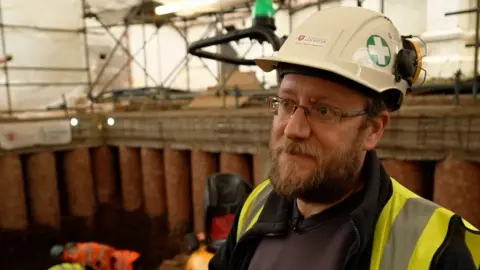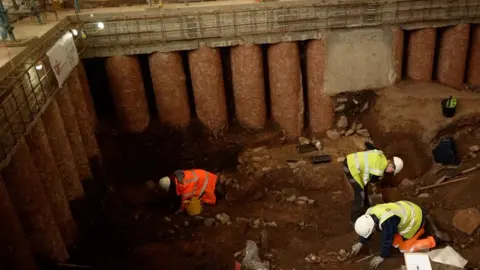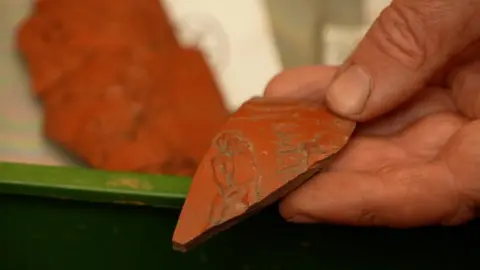Roman shrine discovered near Leicester cathedral graveyard
 BBC
BBCArchaeologists have discovered what they believe to be a Roman shrine buried beneath a former graveyard next to Leicester Cathedral.
The cathedral closed in January 2022 to allow for the construction of a visitor and learning centre.
During excavations, which have been carried out as part of the £12.7m project, thousands of finds have been uncovered.
It is hoped some of them will be displayed in the new centre.
The finds include a broken altar base, which was discovered in what would have been the basement of a large Roman building close to the external wall of the modern cathedral.

"There's always been a tradition that the cathedral was built on a Roman temple, based on antiquarian discoveries in the 19th Century," said Mathew Morris, excavation director for the University of Leicester's Archaeological Services (ULAS) which carried out the dig.
"We're now finding a Roman building that looks like it had a shrine status to it.
"There are no tests that can prove what it was. That it was a shrine is the most likely theory, but there aren't really any others."
He added he believed it was likely used as part of a shrine to a god like Mithra, Dionysus or Isis.

He said the find suggested the site had a sacral heritage dating back 2,000 years.
"It's proving significant. It's only a tiny little area of Leicester, but the material we've recovered from it, the burials, the Roman archaeology underneath, are going to be a key insight into the city," he said.
Other finds at the site have included Roman coins from the First and Fourth Centuries, a perfectly preserved Roman hairpin, the remains of a brooch and some fragments of Gaulish pottery with representations of a gladiator, as well as a Pegasus or gryphon.
The dig took place less than 50m (164ft) from where the remains of King Richard III were famously discovered.

Analysis

The dig has unearthed a wealth of new evidence about Roman Leicester, or Ratae as it was known, but also much more evidence about Anglo-Saxon and medieval Leicester.
Previously the earliest mention of St. Martin's Church - the building that became the cathedral in the 20th Century - was a written record from the 1220s.
As a result of this dig, it is possible to prove there was a church on the site much earlier.
Until the Victorian era the site was used as the church's graveyard, and more than 1,100 sets of human remains have been recovered during the dig.
On the day I visited they recovered three Norman burials, and at an even lower level they found skeletons from two children from pre-Viking Leicester, when it was part of the Anglo-Saxon kingdom of Mercia.

The remains have been photographed, labelled, and boxed up before being taken away for further analysis, including carbon dating.
Simon Bentley, project director, said he hoped when the new centre opened - in June 2024 - the altar base, as well as some of the other finds would go on display.
"I would hope we would be able to display it to the public in the new visitor and learning centre," he said.

Follow BBC East Midlands on Facebook, on Twitter, or on Instagram. Send your story ideas to [email protected].
